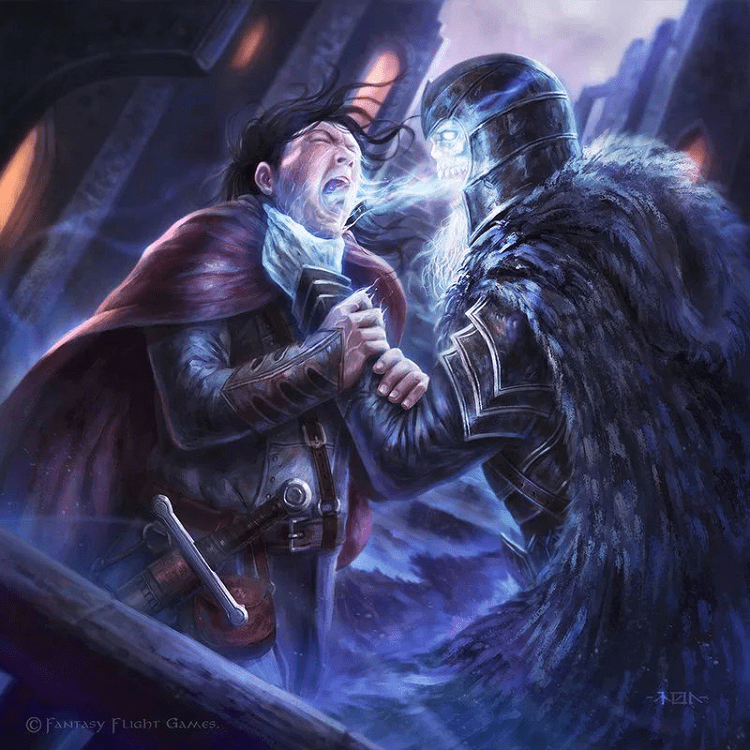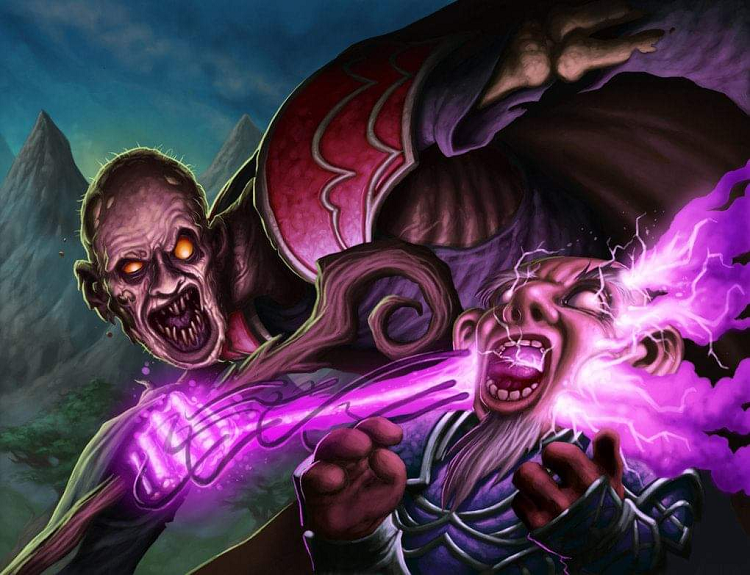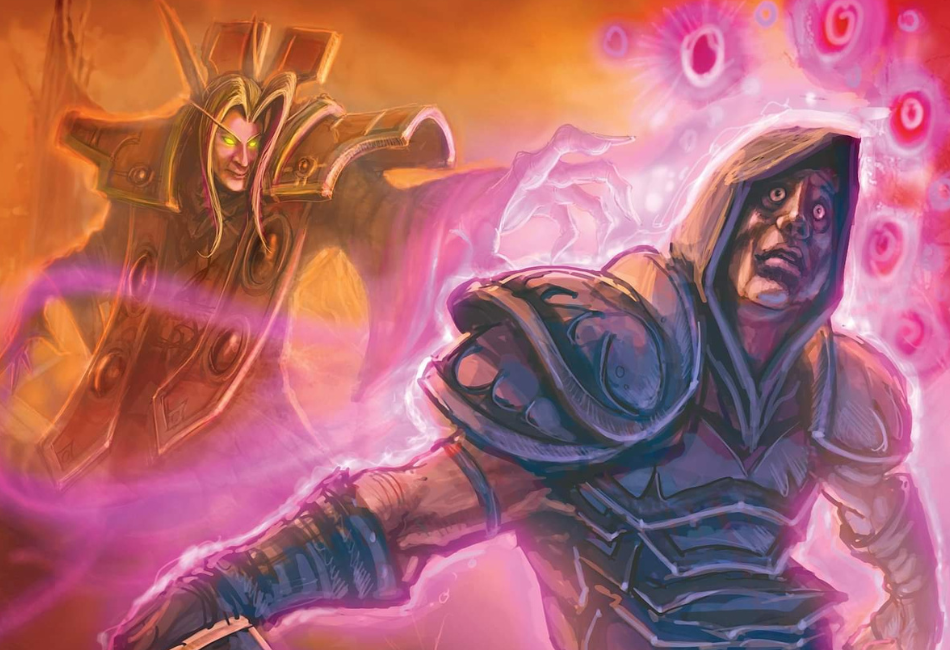Shadow wraps around your hand, drifting up your arm and wisping away. The darkness almost makes your hand appear clawed and monstrous, though you feel nothing. The magic is not cold or warm; it doesn’t even cause a faint fuzziness on the tips of your fingers as other spells do.
Not until your hand slams onto the back of your target—an enemy who had previously struck you for several hit points. Suddenly the magic bursts into life with a pleasant coolness as it activates, draining your enemy of his health.
Some of that health is absorbed by the magic, but the rest is absorbed by you, knitting your wounds together and restoring some hit points.
Your Vampiric Touch has healed you and, in turn, knocked your enemy down just enough hit points that your party’s Barbarian quickly finishes them off. Vampiric Touch has once more proved a life-saver for the exceptionally low-AC and low-HP Wizard. Welcome to a Vampiric Touch 5e Guide.
At A Glance
Vampiric Touch is a third-level Necromancy spell available to Warlocks, Wizards, and clerics of the Death and Grave Domains. This spell allows casters to touch a target and sap health from them. If you succeed on your attack roll, the target takes 3d6 necrotic damage.
You regain hit points equal to half the amount of damage your target took—the damage increases by 1d6 for every spell slot used above third level. Vampiric Touch is one of the more useful healing spells, dealing a fair amount of damage while restoring health to you.
The only qualm I have with it is that you need to remain within attack range in order to use it, meaning that you can lose those hit points just as quickly as you gained them. Regardless, it is a somewhat powerful low-level spell.
When paired with the disengage bonus action and a rapid movement away from enemies, however, it can be a quick and easy way to heal yourself while still dealing a hopefully significant amount of damage.
What is Vampiric Touch?

Vampiric Touch is a spell found in the base game of Dungeons and Dragons, located on page 285 of the Player’s Handbook.
- Third-level Necromancy
- Casting Time: 1 Action
- Range: Self
- Target: A creature within reach
- Components: Verbal, Somatic
- Duration: Concentration, Up to 1 minute.
- The touch of your shadowed hand can steal the life of others to heal your wounds. You must make a melee spell attack against a creature in your reach. On a hit, your target takes 3d6 necrotic damage. You regain hit points equal to half of the damage rolled. Until the spell ends or your concentration is broken, you can make the attack again on each one of your rolls. Your hand must remain on the target during each attack, however.
- This spell’s damage increases by 1d6 for each spell slot level above third.
Because this is a concentration spell, I generally rule that you don’t have to expend another spell slot if your target moves away. So long as your concentration on the spell isn’t broken or one minute isn’t up, you could theoretically attack another target without using a second spell slot.
Because of this, Vampiric Touch is handy for low-level characters who may not have a lot of spell slots or for those who want to conserve their spell slots for other things, regardless of level.
Vampiric Touch doesn’t restrain your target or incapacitate them, so it’s best to try and make sure that they can’t move or won’t move if you’re going to use this spell for multiple rounds in a row—unless you’re comfortable making an attack roll every time.
Who Can Steal HP and The Usefulness
So, we’ve determined what Vampiric Touch is, but don’t get your hopes up yet—there’s a chance that you may not even be able to use it. Unfortunately, Vampiric Touch is a spell limited to only a few classes. Wizards, Warlocks, and Clerics of the Death and Grave Domains are the lucky ones.
Cleric – Death and Grave Domains

Clerics gain access to third-level spells after reaching level five. They get two third-level spell slots and, due to their nature as clerics, can take any spell off of their provided spell lists without having to learn them first.
Death and Grave Domain Clerics will immediately gain access to the Vampiric Touch spell and can use it as they please, so long as they have chosen that spell after or during their long rest. Vampiric Touch can be a good way for Clerics to feel useful in a fight while making sure that they keep themselves alive.
Considering that this spell usually requires you to be upfront and in the action, I recommend that you make sure your Cleric has a decent AC before using it. The last thing anyone needs is for the Cleric to go down in battle, considering that most parties, in my experience, only have one healer—if that.
Wizards
Like Clerics, Wizards need to reach level five before gaining access to their third-level spell slots. They also gain two third-level spell slots, but, unlike clerics, they need to choose to learn Vampiric Touch first.
However, there is a minor workaround to this dilemma. If you didn’t decide to learn Vampiric Touch as one of your spells, you could wait until you level up to take it, or you can search for spell scrolls. Wizards can copy spell scrolls into their spell books and, in that way, learn their desired spells.
Just make sure that your coin purse is heavy with gold or that you have exceptionally sticky fingers and high stealth. A Scroll of Vampiric Touch can average about 400 gold pieces according to 5eMagicShop, and in the early game, there’s a strong chance you don’t have that much money to just throw around. Regardless, it is worth looking into and talking to your DM about.
Warlocks
Warlocks also gain access to their third-level spell slots at level five. Unlike Clerics and Wizards, however, they will only have third-level spell slots with a grand total of two slots. This means that Warlocks must be exceptionally picky about what spells they take to utilize their action economy to the best of their ability.
In that right, Vampiric Touch is the perfect spell. Most battles don’t last more than 10-rounds (1-minute), so assuming you keep Vampiric Touch active for the entire time or you don’t cast another concentration spell, as a Warlock, you can utilize only one spell slot for the entirety of combat and deal upwards of 3d6 damage on each round.
Not to mention, Warlocks are usually hardier than Wizards and have less demand for other spell-utilization than Clerics. It’s almost as if Vampiric Touch was made for Warlocks in 5e.
Irony
One of the most ironic things is that, despite being named after them, Vampires do not have innate access to Vampiric Touch. Even Dhampirs, introduced in Van Richten’s Guide to Ravenloft, don’t have access to Vampiric Touch.
There are other ways for them to sap your health for their own benefit, like their Bite attack, but unless they are classed into one of the above groups, they won’t have access to the spell.
Of course, this is just what is provided to you through the player’s handbook and Van Richten’s Guide to Ravenloft—Dungeon Masters technically have complete control over their games. So, if they wanted to change this feature to be innately available to Vampires and Dhampirs, I am all for it.
Taking a Creative Turn

Now that we know just how useful Vampiric Touch can be and which class it can work best for, we can wonder just how we can get creative with this spell. Outside of combat, there aren’t that many options to use obviously-damaging spells, but if you want to get a bit dark, consider using Vampiric Touch for interrogation.
If you’re trying to get information out of an NPC, Vampiric Touch is one of the most perfect spells. Spells like Zone of Truth or Charm person are generally non-harmful, but they have a high chance of not succeeding or getting you the information that you need.
On the other hand, Vampiric Touch can be used to both intimidate and cause a minor amount of obvious and terrifying damage. With enough “persuasion,” you might just convince your target to divulge their information.
However, that is a rather dark route to go down with your spell, and it might not be for everyone. There are other ways to get creative with it, and depending on your DM, you might just be able to get away with it.
Suppose you’re a Wizard, Warlock, or one of the specified-domain Clerics. In that case, you could theoretically follow behind your Barbarian or be their backpack while they’re raging. Using Vampiric Touch, you could continually damage them for one minute while dealing the least amount of damage (3).
During this time, your Barbarian would be continuously raging and would gain advantage on all of their Strength checks and saving throws and would gain a +2 to all Strength-based attacks.
When I was first considering this option, I thought it would be easier to just multiclass into Barbarian, but an issue arises with that – Barbarians can’t concentrate on spells while raging in 5e. So, unfortunately, as a spell caster, you are just going to have to be a backpack.
FAQs
Question: Can You Use Touch-based Spells on Yourself?
Answer: I rule at my own games that you can, but in the case of Vampiric Touch, I’m not sure why you would want to. The returns would be diminishing, and you’d essentially just be losing half the hit points of whatever damage you rolled.
Question: Is Vampiric Touch Good?
Answer: ABSOLUTELY. I adore this spell and think it can be incredibly useful. It may be scary to get up close and personal with enemies when you’re an exceptionally squishy character, but utilizing Vampiric Touch with Disengage can be a life-saver and make you a serious threat on the battlefield.
Not to mention I think that this spell is a must-have for any gothic-themed character.
Question: Can You Use Vampiric Touch on Undead?
Answer: You can theoretically use it on anything and anyone. The biggest problem you’ll face is that some Undead are resistant, if not outright immune, to necrotic damage. If they’re immune, you won’t see any return from Vampiric Touch, and it would have been a waste of a spell.
If they’re resistant, your damage is halved, and thus, the HP you managed to steal will also be halved. In general, it would probably be best to avoid using this spell on Undead creatures just to play it safe.
Question: Does Vampiric Touch Work with Extra Attack?
Answer: No, it probably wouldn’t… at first. Spell casting classes don’t gain access to the Extra Attack feature. If you were to multiclass, there is a chance that you could gain access to the feature, but Vampiric Touch likely wouldn’t be worth it anyway. Extra Attack specifically refers to using the Attack Action rather than using a Spell Attack Action.
Once you’ve cast a spell, Vampiric Touch becomes the Action Cast a Spell, which allows you to make an attack with that spell due to its instant casting time.
This means you cannot utilize Extra Attack when casting it. However, due to its nature as a concentration spell lasting up to one minute in the rounds following, assuming the spell is kept up and active, I would rule at my own table that yes, you can utilize Extra Attack with it.
Regardless of if this loophole is utilized or not, you would probably be better off just making an Extra Melee Attack with your weapon.
The Final Heal

All-in-all, Vampiric Touch is one of the most useful spells, especially in the early game. This spell saves on spell slots (which is exceptionally useful for Warlocks, even in the late game), and it helps to heal you. Pair it with disengage, and you can keep yourself and your low AC perfectly safe.
There are ways to get creative with it; you just need to think outside of the box and have a bit of leniency from your Dungeon Master. This is one of the spells I always doubted when I first played Dungeons and Dragons, considering that I was an exceptionally squishy Cleric.
The thought of getting up close and in the action was something that I dreaded, and this spell put me right up next to the enemies. However, with more experience, and full knowledge of what the Disengage action does, I can fully utilize my action economy.
You can fully utilize your own action economy now too! I highly encourage you not to underestimate Vampiric Touch in the early or late games. It comes in the most use during the early games, but I promise you, conserving your spell slots will still be useful when you are nearing the end of your games.
- Hand Crossbow 5e Guide – For Everyone but Druids and Wizards - December 16, 2022
- Compelled Duel 5e Guide - November 14, 2022
- Heavily Obscured 5e Guide – The Ins And Outs Of The Dark - October 31, 2022

